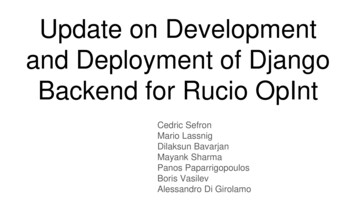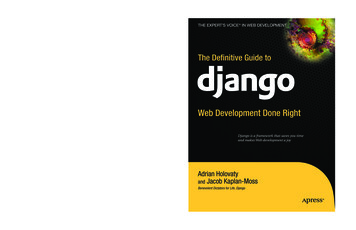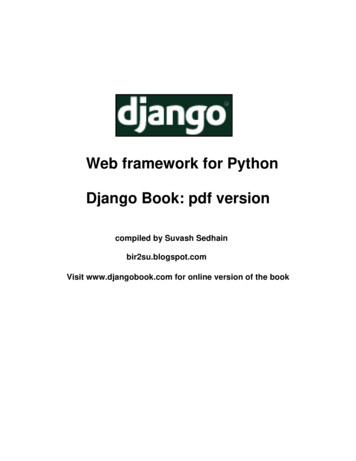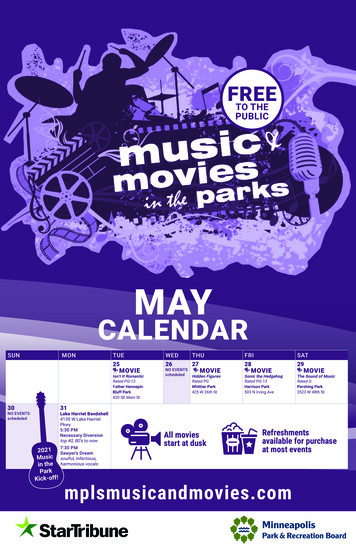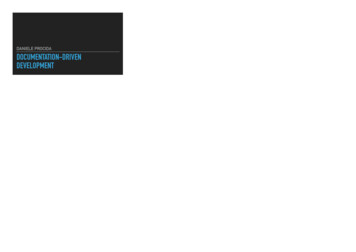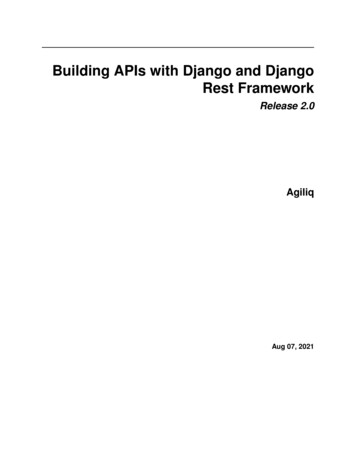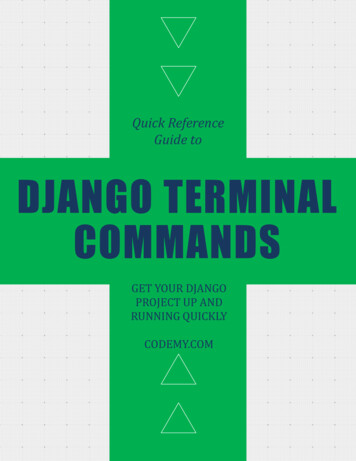
Transcription
Quick ReferenceGuide toDJANGO TERMINALCOMMANDSGET YOUR DJANGOPROJECT UP ANDRUNNING QUICKLYCODEMY.COM
Hiking the Valley of Fire Outside Las Vegas:Welcome to my Django Terminal Commands Quick Reference Guide!In this guide I’ll show you some of the most common DjangoTerminal Commands that you’ll need to work with Django. Sure, youprobably already know all these commands, but it’s really nice tohave them all in one place where you can grab them at a quickglance if you need them!This is not meant to be a comprehensive guide, but rather a quickglance sheet to get you up and running with commands quickly asyou need them. I’ll also talk about some of the regular things youneed to do every time you create a new Django Project.Enjoy!-John ElderCodemy.comLearn To Code At Codemy.com
TA B L E O F C O N T E N T S4Quick ReferenceCommands6New ProjectWalkthru14Django TutorialsOnline22Conclusion23Codemy.com SpecialOffer
Section OneQUICKREFERENCEGUIDETITLEOF THISCHAPTERDJANGO COMMANDSSHALL GO HERE
QUICK REFERENCE GUIDE TODJANGO COMMANDSThis is not meant to be a comprehensive list, just some of themost common Django commands INSTALL VIRTUALENV: pip install virtualenvSTART VIRTUALENV POWERSHELL: virtualev .(first be sure to Set-ExecutionPolicy Unrestricted in powershell)START VIRTUALENV GITBASH: python -m venv nameofVirtualenvACTIVATE VIRTUALENV POWERSHELL: ./Scripts/activate(sometimes . ./Scripts/activate)ACTIVATE VIRTUALENV GITBASH: source virtualenvDIR/Scripts/activateACTIVATE VIRTUALENV MAC: source bin/activateDEACTIVATE VIRTUALENV: deactivateINSTALL DJANGO INSIDE VIRTUALENV: pip install django(pip install django 2.04 to install a specific version of django)START A NEW DJANGO PROJECT: django-admin.py startproject projectnameRUN THE SERVER: python manage.py runserverCREATE DATABASE MIGRATION: python manage.py makemigrationsMIGRATE THE DATABASE: python manage.py migrateCREATE ADMIN USER: python manage.py createsuperuserCREATE ADMIN USER GIT BASH: winpty python manage.py createsuperuserCREATE NEW APP IN PROJECT: python manage.py startapp APPNAMELearn To Code At Codemy.com
Section TwoSTARTINGPROJECTTITLEOF THISNEWCHAPTERTHINGS TO DOSHALL GO HERE
S TA R T I N G A N E W P R O J E C T :THINGS TO DOStarting a new project? There’s always a few things to doright off the bat. Let’s talk about them!So you’re creating a new Django project. You have your virtual environmentset up and initiated, you’ve installed Django and started a new project, andadded an app to it. Now what?SETTINGS.PYThe first thing to do is add your newly created app (let’s call it “posts”) to yoursettings.py file.INSTALLED APPS files','posts',]Notice the ‘posts’, there at the bottom. That’s what we want to add. Save/exit.Learn To Code At Codemy.com
ORIGINAL URLS.PYWhen you start your project, a URLS.PY file will be generated. But it needs tobe modified and you need to create a second URLS.PY file in the new app yougenerated.Let’s take a look at the original URL.PY file and how you need to modify it from django.contrib import adminfrom django.urls import path, includeurlpatterns [path('admin/', admin.site.urls),path('', include(‘posts.urls')),]What we’ve added is the “include” module to the second line, as well as thenew path(“”, include(‘posts.urls’)) line.That line points to the new URLS.py file we will create next in the postsdirectory (assuming the new ‘app’ you created is called posts. If you called itsomething else, modify that line with whatever you called it.Learn To Code At Codemy.com
NEW URLS.PYAfter you’ve modified your original URLS.PY file to point to your new URLS.pyfile, you need to actually create the new URLS.py file! Add that to the directoryof your new app. We’re calling our new app “posts” so you’ll add it to the postsdirectory.Once you create the file, add this code to it:from django.urls import pathfrom . import viewsurlpatterns [path('', views.home, name "home"),path('about.html', views.about, name "about"),path('add post.html', views.add post, name "add post"),path('delete/ post id ', views.delete, name "delete"),path('delete post.html', views.delete post, name "delete post"),]I’ve added some dummy urlpatterns in the code just to give you an idea of thetype of things you’ll eventually add there.It’s important to import your views (line 2 of the code) because you need themto create pages for your website.The rest is boilerplate Django Learn To Code At Codemy.com
C R E AT E A T E M P L AT E S D I R E C T O R YThe next thing you’ll need to create is a templates directory.The templates directory is where you’ll keep your base.html file and all of the.html webpage files that go with your project.We’re ever.htmland on and on The templates directory should go in the posts directory (or whatever younamed your app).A common error is to place the templates directory in your main projectdirectory. Don’t do that! It goes in your app directory.Learn To Code At Codemy.com
C R E AT E A S TAT I C D I R E C T O R YThe next thing you’ll need to create is a Static directory.The Static directory is where you’ll keep your images, css, and any javascriptyou might need.Create the static directory in the main directory of your project (not in the appdirectory where your views.py file is for instance). Inside of that directory,create an images directory, a css directory, and a javascript directory.In each of those directories place your images, css, and javascript respectively.MODIFY YOUR SETTINGS.PY FILEIn your settings.py file, at the bottom of the file, under the lineSTATIC URL '/static/‘Add this bit of code STATICFILES DIRS [os.path.join(BASE DIR, 'static'),]Finally, to access things in your static directory, for instance an image calledme.png in the images directory in the static directory, place this code on yourweb page under the {% extends ‘base.html %} line:{% load static %}And then to place the actual thing on the page (ie our me.png image): img src “{% static ‘images/me.png’ %}” Learn To Code At Codemy.com
A D D A D ATA B A S E M O D E LIt may be a little early to start talking about database stuff. But if you’replanning on using a database in your project, you need to create a model classin your models.py file inside of your app directory.Since this isn’t really an in depth book on Django, I’m not going to go into this,well in depth. I’ll just give you a very basic model with one field.MODELS.PYfrom django.db import modelsclass Post(models.Model):title models.CharField(max length 200)def str (self):return self.tickerAs you can see, this just creates a basic class called Post, that has one fieldcalled title.To migrate this model and shove it into the database for use, issue these twocommands from the terminal:python manage.py makemigrationspython manage.py migrateThe first command creates the migration, the second one pushes it (migrates)into the database.Learn To Code At Codemy.com
ADD YOUR MODEL TO ADMIN SECTIONOnce you’ve created a model class in your models.py file, created a migration,and then pushed the migration into the database you can add your model tothe ADMIN section of the site (localhost:8000/admin).To do this you need to register you model in the admin.py file, located in theapp directory of your project.ADMIN.PYfrom django.contrib import adminfrom .models import Postadmin.site.register(Post)That’s pretty much all there is to it. Notice the Post in the second line and thePost in the third line reference the name of the class we just created in themodels.py file. If you called your model “Stocks” for instance, you wouldreplace the word Post With Stocks above.Once you add those three lines of code to your ADMIN.PY file, your databasemodel will appear in the Admin section of your site, located atlocalhost:8000/adminLearn To Code At Codemy.com
Section ThreeONLINETITLE OFTHISTUTORIALSCHAPTERWHERE TO LEARN MORESHALL GO HERE
Intro To Django For Web DevelopmentLearn the absolute basics of Django from theground up in this course. Perfect for beginners.Take Course: Udemy CodemyDjango & Python: To-Do List AppWe’ll build a cool To-Do List app! Learn how touse Databases with DjangoTake Course: Udemy CodemyBuild A Stock Market App With DjangoWe’ll build an even cooler Stock Market App toget real time data and databasesTake Course: Udemy CodemyBuild a User Authentication AppAllow people to sign up for your web app, login, log out, edit their profiles, and more Take Course: Udemy CodemyCrypto Currency News With DjangoBuild a Crypto currency News App! Learn howto connect to a 3rd party Crypto API and moreTake Course: Udemy CodemyPush Django To Heroku for WebhostingLearn to host your Django apps on Heroku forprofessional webhosting.Take Course: Udemy Codemy
Intro To Django with Python ForWeb DevelopmentIn this course you'll learn how to build simple websites with Django andPython!Django overwhelms a lot of people, and it doesn't have to! If you understandjust a few basic concepts, you'll see that Django is a breeze to use!In this course I'll be developing on a Windows machine, but you should be ableto follow along if you're on a Mac or Linux. I'll show you how to download andinstall Python and Django, and create a basic website.We won't be doing ANY database work in this course. I feel like databasesconfuse a lot of newbies, so instead of getting bogged down in all of that, we'rejust going to skip it and focus on building basic static websites.You'll be able to build simple personal websites, or simple business websiteswhen you're finished with this course.TAKE COURSE: UDEMY CODEMY
Django & Python: To-Do List AppIn this course I’ll walk you through it step by step and you’ll be building yourfirst web app in MINUTES. You’ll be amazed how quick and easy it is to createvery professional looking websites, even if you have no programming or webdesign experience at all.Watch over my shoulder as I build a cool To-Do List app step by step right infront of you. You’ll follow along and build your own copy. By the time we’refinished, you’ll have a solid understanding of Django and how to use it to buildawesome web apps.The course contains 28 videos – and is just over 2 hours long. Watch thevideos at your own pace, and post questions along the way if you get stuck.You don’t need any special knowledge or software to take this course, thoughany experience with HTML or CSS is a plus. You don’t even need to know thePython programming language. I’ll walk you through EVERYTHING.Django is a great web development tool and learning it has never been thiseasy.TAKE COURSE: UDEMY CODEMY
Build a Stock Market Web App WithPython and DjangoWatch over my shoulder as I build a cool Stock Market app step by step right infront of you. You’ll follow along and build your own copy. By the time we’refinished, you’ll have a solid understanding of Django and how to use it to buildawesome web apps.The course contains 39 videos – and is just over 2 hours long. Watch thevideos at your own pace, and post questions along the way if you get stuck.You don’t need any special knowledge or software to take this course, thoughany experience with HTML or CSS is a plus. You don’t even need to know thePython programming language. I’ll walk you through EVERYTHING.We’ll connect to a third party API to get our stock market data. Once you learnto do this, you can use literally any API online in your Django Apps!There’s lots of moving parts to this app, and it’s a lot of fun!TAKE COURSE: UDEMY CODEMY
User Authenticate WithPython And DjangoWe'll build a cool User Authorization app that let's users sign up (register) foryour site, log in, log out, edit their profile, and change their passwords. Thesedays just about every website let's people sign up and log in, and you reallyneed this skill if you want to build modern web apps.We'll style the website using the popular Bootstrap CSS framework (I'll showyou how to use it!)The course contains 30 videos – and is just over 2 hours long. Watch thevideos at your own pace, and post questions along the way if you get stuck.You don’t need any special knowledge or software to take this course, thoughany experience with HTML or CSS is a plus. You don’t even need to know thePython programming language. I’ll walk you through EVERYTHING.This is one of my best-selling Django courses because it’s such an importantskill to learn, and it’s surprisingly easy to pick it up!TAKE COURSE: UDEMY CODEMY
Crypto Currency News With Python& DjangoCrypto currencies are all the rage right now. Wouldn't it be cool to build awebsite that shows Crypto news automatically? That's what we'll learn in thiscourse!We'll build a website using Django and Python and Bootstrap that connects toa free third party crypto API.We'll be able to pull news stories, crypto price data, and all kinds of cool stuff,and output it onto the screen of our website automatically.Who Should Take This Course?This course is aimed at the beginner. You don't need to know Python, orDjango, or Bootstrap.or anything at all.to take this course. I'll walk youthrough it all; step by step. If you already know the basics of any of thosethings, you'll be fine too. You'll still learn some cool things along the way!TAKE COURSE: UDEMY CODEMY
Push Django Apps To Heroku forWeb HostingSo you know how to build Django apps with Python, but aren't sure how to getyour app up onto the Internet? This course if for you!With many other programming languages and web frameworks, pushing yourcode up to the Internet for web hosting is relatively easy.With Django it’s a bit harder. Well, harder may not be the rightword complicated may be a better way to put it! It’s actually fairly easy topush your Django code online to a web host, but you have to tinker with quitea few settings and do a few things to your app that aren’t necessarily intuitive.In this course I’ll show you how to push your code up to Heroku, the massivelypopular web hosting service. Heroku has a free tier that we’ll be using and isgreat for learning how to do all this stuff.See you inside!TAKE COURSE: UDEMY CODEMY
Thanks For Reading!I hope you enjoyed this short ebook on Django Commands and settingup new Django projects!If you’d like to learn more about Django, I’d love to see you in one of mycourses either at Udemy or on my own website, Codemy.com Check outa special discount offer for ALL my courses on the next page.-John ElderCodemy.com“As we look ahead into the next century,leaders will be those who empower others.-Bill Gates
SIGN UP FOR CODEMY.COMUse coupon code: djangocoder and get 22 off totalmembership! You pay just 27 (one time fee) forALL of my courses, all my future courses, and all my#1 Best-Seller Coding Books!S I G N U P T O D AY
from django.contrib import admin from django.urls import path, include urlpatterns [ path('admin/', admin.site.urls), path('', include('posts.urls')), ] What we've added is the "include" module to the second line, as well as the new path("", include('posts.urls')) line.
